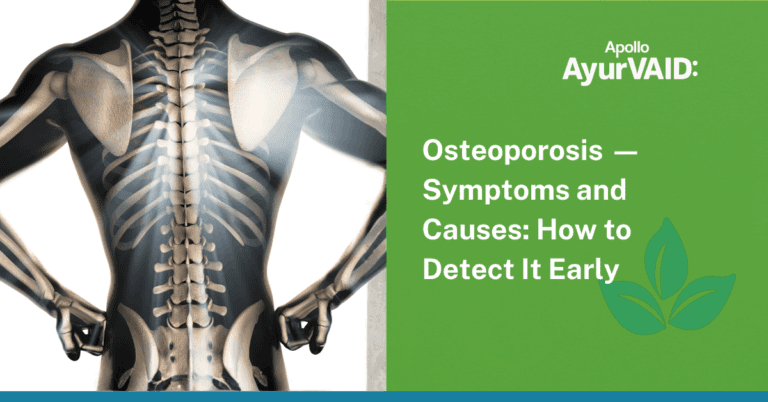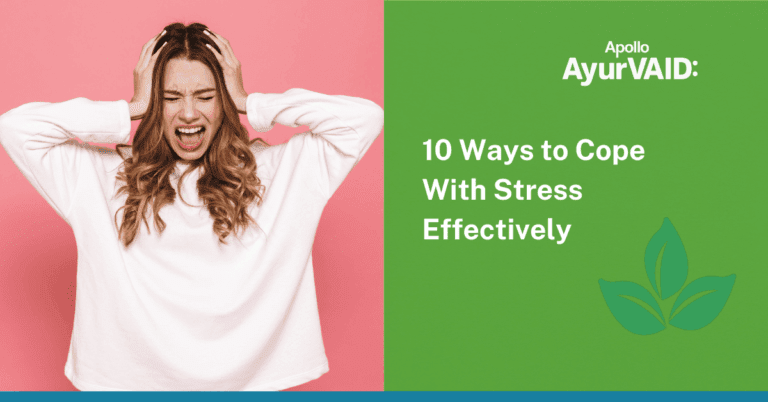
Understanding Migraine Through Ayurveda
Etiology
Migraine aetiology consists of factors that disturb Vata and Kapha, or both together.
- Causes are excessive intake of dry or oily foods, exposure to cold, suppression of natural urges, fatigue, and excessive physical exertion.
- Repeated consumption before the digestion of the last meal, difficult-to-digest food, and excessive consumption of cold water cause Kapha vitiation and the formation of ama.
- Emotional stress is an important precipitating cause.
- The primary doshas involved are Vata and Pitta, leading to a pounding headache.
- Symptoms of migraine tend to align with Amlapitta, so therapies enhancing digestive fire become significant.
Comprehensive Migraine Treatment in Ayurveda
Ayurveda takes a holistic approach to migraine treatment, emphasising the removal of the source of the ailment and balancing the mind-body mechanism. The therapeutic approach generally has two major branches: Shodhana (purificatory) and Shamana (pacifying) therapy.
Shodhana Measures: These are procedures designed to flush out imbalanced doshas from the body, conferring a more drastic and longer-lasting relief.
Nasya (Nasal Instillations): It is an important bio-purificatory intervention wherein medicated oils or other preparations are instilled through the nasal route. Medicines introduced nasally are said to enter the brain directly, radiating their efficacy to the head, eyes, ears, and throat, thus removing morbid doshas. The submucosal vasculature and the nasal epithelium absorb the medicine quickly, and there is direct access of the drug into systemic circulation. Research has found Nasya to help alleviate the intensity, frequency, and duration of migraine headaches and accompanying symptoms such as nausea, vomiting, vertigo, and aura.
Virechana (Therapeutic Purgation): This treatment consists of induced purgation to flush out cellular fluid and dissolved biochemicals into the gastrointestinal tract for elimination. Virechana aids in biochemical modification and regulates fluid spaces, enhancing the metabolic status of the body and the effectiveness of follow-up oral medication.
Siravyadha (Bloodletting/Vein Puncture): When other therapies fall short, Rakthamokshana (bloodletting) therapies such as Siravyadha can be followed.
A case study revealed improvement in migraine symptoms such as photophobia and hot sensation, as well as lowering of the Migraine Disability Assessment Scale (MIDAS) and Numerical Pain Rating (NPR) ratings after Siravyadha. It should be noted that Siravyadha is a customised procedure as per the patient’s condition.
Other External Therapies: Ayurveda has some other external therapies:
Shirolepa: Topical application of herbal pastes on the forehead to calm Pitta Dosha.
Shirodhara: A steady flow of medicated fluid (oils, milk, or buttermilk) over the scalp, which provides a soothing effect and balances Vata and Pitta.
Shirovasti: Keeping medicated oils in a leather cap placed on the scalp can calm the mind and reduce stress.
Agnikarma (Cautery): Heat cautery over the involved area, stimulating pain-inhibitory nerve fibers and serving as a counter-irritant.
Shamana Medicaments: Oral medicines in the form of medicated ghee relieve symptoms and re-establish dosha balance.
Effective Home Remedies and Lifestyle Adjustments
Nidana Parivarjana (avoidance of causative factors) is the foundational principle and often the most effective step in migraine treatment in Ayurveda.
Dietary Changes
Avoid: Too much dry/coarse foods, pre-digestion eating, missing meals, heavy food, too much cold water. In particular, do not take baked foods, chocolate, dairy, heavy non-veg, onion, peanuts, processed foods, fermented foods, and spicy foods, as they may provoke attacks by raising Kapha or Pitta Dosha.
Include: Old ghee, coconut oil, certain vegetables such as ridge gourd, drumstick, grapes, bitter gourd, and Indian gooseberry, and fruits like pomegranate and citron, and liquids such as buttermilk and coconut water.
Lifestyle Changes
Stress Management: As stress and anxiety are key precipitants for migraine attacks, maintaining good sleeping habits, regular exercise, and practising relaxation techniques such as yoga and pranayama are essential.
Sleep Habits: Practice good sleep habits, getting at least 7 hours of sleep at night. Refrain from too much sleep, less sleep, napping during the day, and nighttime awakenings.
Environmental Stimuli: Refrain from excessive sunlight or bright light exposure, loud noises, and overpowering perfumes/odours. Use sunglasses, provide good ventilation, and abstain from prolonged AC usage.
Substance Abstinence: Stop smoking and keep alcohol consumption minimal. Gradually withdraw from coffee/tea.
Physical Activity: Moderate, regular exercise is helpful. Do not overexercise. Morning walk in the fresh air is beneficial.
Anger Management: Try to avoid getting angry and stay calm.
Constipation: Treatment of constipation and gastritis symptoms (burning, bloating) is highly effective because most of the migraine patients have these symptoms.
Specific Home Remedies for Migraine Headache
Coriander Seed Water: Let 1 teaspoon of coriander seed powder soak in one cup of water overnight and have it on an empty stomach the following morning.
Soaked Raisins and Almonds: Soak 5 raisins and 5 almonds in water at night and consume them in the morning after peeling off the skin of the almonds.
Saffron and Ghee Instillation: Mix 1 teaspoon of ghee with a small pinch of saffron powder and instil 2 drops into both nostrils on an empty stomach in the morning. It is advisable to do a facial massage with sesame oil, followed by mild hot fomentation, before this home remedy for migraine headaches. Avoid it on cloudy days and consult an Ayurveda doctor.
Sandalwood Paste: Application of this paste to the forehead may help relieve migraine pain.
Yoga and Pranayama for Migraine Treatment
Nadi Sodhana: Close one nostril and breathe through the other for 5 minutes. Do this for 15 to 20 minutes every day, preferably on an empty stomach.
Cooling Pranayama: Curl the tongue sides to create a tube, inhale through the tongue, swallow, and exhale through the nose.
Yogasanas: Postures such as Hastapadasana, Setubandhasana, Shishu Asana, Marjarasana, Paschimottanasana, Adhomukha Shvanasana, and Shavasana.
Avoid breath-holding exercises in Pranayama to prevent aggravating migraine headaches.
Conclusion







